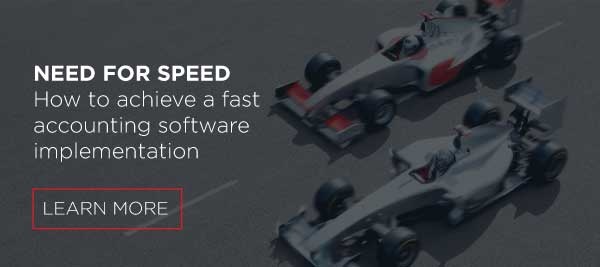How to reduce the cost of implementing a new accounting system

Thinking of shopping around for a new accounting solution? If your current software isn’t meeting the needs of your growing business, it’s likely that you could hugely improve your efficiency by implementing a newer system that can automate more tasks.
That said, shopping for a new system can be challenging due to the difficulty in comparing apples to apples. Not only must you be sure a new product includes all the features you need and want, but you need to be clear on the hidden costs before making a decision.
Incorporating new software is a process
Unfortunately, managers charged with making such upgrades are often so focused on purchase prices they don’t factor in the costs of getting all users on board.
“The most painful part can often be figuring out the human side of a new platform internally,” notes Russell Smith of Rainforest QA in Forbes. “Make sure you have good answers to these questions before you commit to buying or implementing something new: Are you getting a return on investment? What does success look like? What process needs to be in place? Who’s going to use it day-to-day? What does expansion look like on this platform?”
Hidden costs shouldn’t come as a surprise
In that spirit, here are implementation costs you may not have considered while shopping for an accounting software package:
Outside consultant fees
Some organizations hire a software consultant to facilitate staff training in the new tool and ensure the transition goes as smoothly as possible, with minimal disruption to regular business processes. To put that in perspective, the average annual salary of an accounting software consultant is $76,592, according to Glassdoor.
Lost productivity
Your team members will need to learn the new and unfamiliar system while also managing their regular workloads. Some people will learn it faster than others, but your departmental productivity will be temporarily reduced as they navigate new features and functions.
Time lost to data conversion
The functionality of your old and new systems could be temporarily compromised and team members may need to put in overtime as information is transferred from one system to the other.
Inefficiencies in implementing new processes
It’s only natural that mistakes will be made and corrected as everyone adjusts to the new operational model, including customers and co-workers from outside your department.
Lower customer satisfaction
Your clientele may become frustrated by compromised business functions, late shipments, inventory issues and other glitches that can happen during a software transition.
Greater employee frustration
Team members, especially those who are less technologically savvy, may feel burdened trying to continue old processes while learning new ones.
What’s the answer? Reducing costs and managing employee expectations
The good news? The efficiencies you can realize with a user-friendly, multifaceted accounting system like Gravity Software® (Gravity) will more than compensate for the challenges associated with implementation. Further, the costs of that implementation process can be minimized if you follow these recommendations:
1. Define your project manager
Assign a single person to be responsible for the implementation. He or she must have the ability to set internal goals, define internal responsibilities and dictate deadlines.
2. Communication rationale
Buy-in is crucial. Everyone in the company must understand the reason for the new system, the advantages offered and the process for getting it established.
3. Address fears about displacement
Some employees may fear their jobs will be eliminated as a result of the improved system. While that’s possible, in many cases more efficient software allows accountants to simply focus more on business strategy rather than routine number crunching.
4. Set an aggressive (but realistic) deadline
A longer time frame may necessitate more meetings and greater coordination of staff and resources. In comparison, a shorter interval may cause a little more stress but end up reducing your overall cost.
5. Encourage users to be open-minded
Ask team members to stay positive when it comes to adopting new ways of doing business that can result in company improvements.
[Related: Why small to medium sized businesses choose Gravity]
How Gravity Software can reduce the cost of implementation
Make your transition to new software easier and more efficient with the intuitive architecture of Gravity Software's cloud-based accounting system. Because it’s so easy to learn and entirely managed through the cloud, the average time needed for a conversion is 30 - 60 days — significantly below industry standard. Instead of requiring you to figure everything out on your own, you can expect our professional advisors will walk you through the entire process. And even with that service, our conversion costs are typically only about $7,000 compared to $25,000 for larger enterprise applications.
Written from scratch on the Microsoft Power Platform (aka Dynamics 365), Gravity brings all your accounting information together on one database within one platform. Contact us to learn more about Gravity's implementation process and how it can transform the way you work. Want one on one attention? Schedule your online demo today!
Gravity Software
Better. Smarter. Accounting.
This article was originally published in March of 2017 and has been updated and edited for clarity


